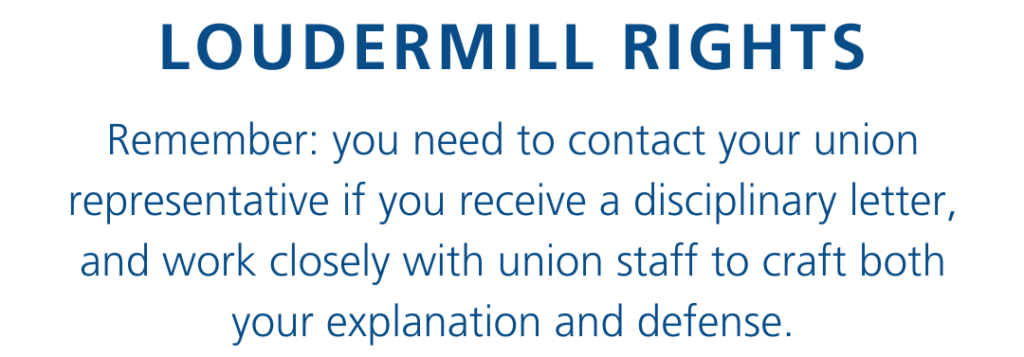More than 20 years ago, the United States Supreme Court issued a hugely important ruling to public sector union members. It stated that non-probationary public employees facing discipline are entitled to certain due process rights.

Besides the notification of those issues, it is primarily an opportunity for members to meet with their representative (or appointing authority) to offer its version of the circumstances prior to the employer making a final decision. At this time, the employer may consider on what level, if any, disciplinary action will be taken. Employees are given a choice of in-person presentation or the option to write a statement.
This case established “Loudermill Rights,” and provides constitutional protection – even if an employees’ contract does not mention this representational right. Loudermill mandates that public employees are entitled to an oral or written notice of charges or allegations made against them and that an explanation be given outlining the employer’s evidence.
The formal letter advising the employee that discipline is being considered, and offering the opportunity for the employee to discuss or present their version and mitigating evidence, may be the first time they are even aware that certain allegations have arisen or that an investigation has been concluded.
The letter usually states that the employee may contact their union representative. The governing contract language may also state that the union representative will receive a copy of the letter. Stewards should counsel any member who approaches them with a question about such a letter to immediately contact their union representative.
Within the Loudermill decision are elements that reinforce how important it is for employees to have notice, disclosure and the opportunity to defend themselves against charges in which the employer may impose disciplinary sanctions, including loss of employment. Loudermill Rights are based on these five components:
- Property Right — Non-probationary public servants are considered to have a property right to their employment and can only be terminated for cause, a standard also applying to other levels of discipline, but not to reprimands.
- Due Process — If one’s employment is a property right, the employee must have proper notice and an opportunity for a hearing, before they are deprived of any significant property right.
- Employee’s Case — There are limits to the employee presentation during a Loudermill hearing. The meeting usually involves a manager from the human resources department and one at the highest program administrator level. The employee does not have an opportunity to cross-examine other people involved, or who may have given a witness statement in the investigation. Prior to the hearing, the employee needs to prepare their case presentation with their union representative. This will include decisions about the role each will play. The statements and information are important to emphasize as mitigating information.
- Before Final Decision — Following the common understanding of due process, the hearing, or written explanation from the member, must occur prior to the final decision on discipline (termination, suspension or demotion). Even if the original letter cites termination as the contemplated decision, the hearing is a unique and extremely important opportunity to present all rationale for the employer to dismiss an erroneously-based investigation and, therefore, its contemplated discipline. Or, at the least, the employee may provide such an explanation that will cause the original sanction to be reduced.
- Hearing Check Against Mistakes — The Loudermill “hearing” sounds like more of a formal process than it usually is; courts assume it fulfills due process rights. The goal of the meeting is to verify the truth of allegations, and whether or not the anticipated level of discipline can be substantiated and then justified.
Remember, members need to contact their union representative if they receive a disciplinary letter, and work closely with them to craft both an explanation and defense.
Click here for a document with a simplified Loudermill Rights overview.


